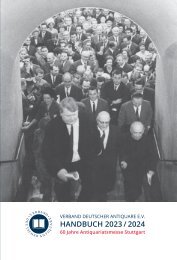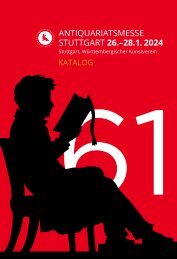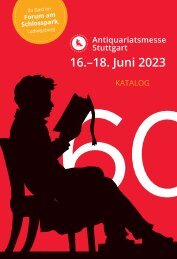Antiquariatsmesse Stuttgart 2022 - Katalog
Katalog zur Antiquariatsmesse Stuttgart 2022: Die diesjährige Antiquariatsmesse Stuttgart, Deutschlands bedeutendste Messe für schöne und seltene Bücher, Autographen, illustrierte Werke und Graphik findet, wie bereits im vergangenen Jahr pandemiebedingt nicht als klassische Messe, sondern in Form des gedruckten Kataloges und als digitale Messe auf bewährter Plattform (18. bis 22. Februar 2022) statt. 73 Antiquariate und Galerien aus Deutschland, Österreich und der Schweiz, den Niederlanden, Frankreich, England und den USA werden auch in diesem Jahr die gesamte Bandbreite des Antiquariatshandels präsentieren. Der gedruckte Katalog wird ab dem 31. Januar 2022 an interessierte Kunden verschickt, die virtuelle Messe öffnet ihre „digitalen Pforten“ am 18. Februar 2022 um 12.00 Uhr unter www.antiquariatsmesse-stuttgart.de
Katalog zur Antiquariatsmesse Stuttgart 2022: Die diesjährige Antiquariatsmesse Stuttgart, Deutschlands bedeutendste Messe für schöne und seltene Bücher, Autographen, illustrierte Werke und Graphik findet, wie bereits im vergangenen Jahr pandemiebedingt nicht als klassische Messe, sondern in Form des gedruckten Kataloges und als digitale Messe auf bewährter Plattform (18. bis 22. Februar 2022) statt.
73 Antiquariate und Galerien aus Deutschland, Österreich und der Schweiz, den Niederlanden, Frankreich, England und den USA werden auch in diesem Jahr die gesamte Bandbreite des Antiquariatshandels präsentieren.
Der gedruckte Katalog wird ab dem 31. Januar 2022 an interessierte Kunden verschickt, die virtuelle Messe öffnet ihre „digitalen Pforten“ am 18. Februar 2022 um 12.00 Uhr unter www.antiquariatsmesse-stuttgart.de
Erfolgreiche ePaper selbst erstellen
Machen Sie aus Ihren PDF Publikationen ein blätterbares Flipbook mit unserer einzigartigen Google optimierten e-Paper Software.
projects for buildings in Moscow … During his long<br />
and busy Russian career, Quarenghi designed numerous<br />
public and private buildings, churches, palaces,<br />
country houses, military installations, and triumphal<br />
arches” (Millard).<br />
Ringelberg, Ioachim Fortius. Ioachimi Fortii<br />
Ringelbergii Andoverpiani opera, quae proxima pagina<br />
enumerantur. 664, [2] pp. Profusely illustrated<br />
with Woodcuts. Small 8vo., 165 × 100 mm, bound in<br />
contemporary blind-stamped pigskin with a Roman<br />
goddess on the front cover, and a portrait of Luther<br />
on the back cover. Lyon: M. Sylvius for J. Frellonius,<br />
1556. € 4400,–<br />
An exceptional copy of the third edition of Ringelberg’s<br />
Collected Works divided in 6 parts: 1. “Ad Grammaticen<br />
pertinent”. 2. “Ad Dialecticen”. 3. “Ad Rhetoricen”.<br />
4. “Ad Mathematicen”. 5. “Ad Diviniationem”.<br />
& 6. “Communis quisdam Naturae sunt”. – Siehe<br />
Abbildung.<br />
Roisecco, Gregorio. Roma Antica e Moderna o<br />
sia nuova descrizione di tutti gl’Edificj Antichi,<br />
e Moderni Sagri, e Profani della Città di Roma.<br />
Three volumes. With a frontispiece, 1 double-page<br />
folding map of Rome, 40 folding engraved plates,<br />
125 full-page engravings in the text, and numerous<br />
wood-cut engravings throughout. 8vo., 167 × 110<br />
mm, uniformly bound in contemporary Italian vellum,<br />
beige spine labels. Rome: Niccola Roisecco,<br />
1765. € 3500,–<br />
Third and Most Complete Edition of Roisecco’s indepth<br />
guide to the antiquities of Rome, profusely illustrated<br />
with full- and double-page engravings throughout.<br />
The work expands upon the researches of Totti and<br />
de Rossi, and includes a third volume on the history<br />
of Rome, complete with a monumental historical, political,<br />
and artistic chronology of the city. Cicognara<br />
discusses the author’s achievement: “Quest’opera serve<br />
notabilmente a chi non sia fornito degli autori da cui<br />
furono tratte le notizie, ed è bastevole per dare un’idea<br />
generale delle cose Romane.”<br />
Schenk, Petrus. Afbeeldinge der voornaamste<br />
Gebouwen van Amsterdam. Contents include: title-page,<br />
index and 100 fine engraved views with<br />
captions in Latin and Dutch. Small oblong folio,<br />
210 × 265 mm, bound in contemporary full English<br />
calf with red morocco spine label. Amsterdam:<br />
1700. € 11 000,–<br />
A rare complete copy of this engraved survey of Amsterdam<br />
and its surrounding regions produced by the<br />
prolific engraver and map publisher Petrus Schenk the<br />
Elder (1660–1711). A fine copy with crisp, dark impressions.<br />
The work’s importance is attested by several<br />
twentieth century reprints.<br />
Vasari, Giorgio. Ragionamenti del Sig. Cavaliere<br />
Giorgio Vasari. Sopra le inventioni da lui dipinte<br />
in Firenze nel Palazzo di loro Altezze Serenissime.<br />
Insieme con la inventione della Pittura da lui<br />
cominciata nella Cupola. [8], 186, [18] pp. Illustrated<br />
with the Giunta printing device with initial “F” on<br />
title-page and, in a different form, on the colophon.<br />
Plus the full-page woodcut portrait of Vasari from<br />
the “Vite” facing page 1. 8vo., 217 × 150 mm, bound<br />
in contemporary Italian limp vellum, title in brown<br />
ink on spine. Florence: Appresso Filippo Giunti,<br />
1588. € 6750,–<br />
First Edition. Giorgio Vasari, considered to be the first<br />
art historian and often referred to as the “father of art<br />
history”, wrote the “Ragionamenti” between 1557 and<br />
1560. A completed first draft was brought to Rome by<br />
Vasari in ca. 1560, where it was read by Annibale Caro,<br />
Michelangelo, Duke Cosimo de’ Medici, Vincenzo<br />
Borghini, and Jacopo Guidi, among others.<br />
The work is written in dialogue form taking place over<br />
a period of three days. The two characters were Vasari<br />
himself and the young Francesco de’ Medici, to whom<br />
the book is dedicated. Although the core text revolves<br />
around the painted commissions Vasari executed in<br />
the Palazzo Vecchio, the “Ragionamenti” can also be<br />
viewed as a supplement to his “Le Vite de’ Piu Eccellenti<br />
Pittori, Scultori, E Architettori”.<br />
Vredeman de Vries, Hans. XII Caesarum Romanorum<br />
Imagines. E numismatibus expressae,<br />
et historica narratione illustrata. By Franciscus<br />
Sweertius. 30 pp. Illustrated with engraved frontispiece<br />
and 12 engraved portraits with elaborate<br />
borders by Hans Vredeman de Vries. Small 4to.,<br />
200 × 140 mm, bound in eighteenth-century Dutch<br />
calf, spine gilt. Antwerp: Ionnus Baptista Vrintius,<br />
1603. € 6750,–<br />
First Edition in book form with the text by Franciscus<br />
Sweertius (1567–1629). A finely engraved series of<br />
portraits of the Roman Emperors from Julius Caesar to<br />
Domitian, each set in elaborate grotesque borders designed<br />
by Hans Vredeman de Vries. Vredeman de Vries<br />
(ca. 1527–1604) was a much celebrated Dutch architect<br />
and draughtsman whose model books and works on<br />
perspective disseminated the new artistic innovations<br />
of Renaissance Italy to Northern Europe. The present<br />
borders feature a harmoniously intertwined cornucopia<br />
of ornamental and allegorical subject matter that<br />
surely would have been used as models for artists and<br />
designers.<br />
205






